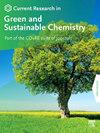Removal of amoxicillin from hospital waste using Fe2O3–Ag adsorbent and optimization by response surface methodology and machine learning prediction
Q2 Materials Science
Current Research in Green and Sustainable Chemistry
Pub Date : 2025-01-01
DOI:10.1016/j.crgsc.2025.100483
引用次数: 0
Abstract
Purpose
Antibiotic pollution in hospital effluent is a significant environmental concern that contributes to the evolution of antibiotic-resistant bacteria. This study aims to provide effective removal strategies for antibiotics from wastewater.
Materials and methods
In this study, Fe2O3–Ag nanocomposites were prepared and characterized to enhance the sorption of Amoxicillin from water. We employed Response Surface Methodology (RSM) and machine learning models (XGBoost and Random Forest) to optimize the adsorption process, maximizing removal efficiency. The optimal conditions for Amoxicillin removal were determined to be a pH of 6.5, a contact time of 26 min, a temperature of 45 °C, and an adsorbent dosage of 0.185 g. Adsorption isotherm and kinetic studies indicated that the process followed the Langmuir model and pseudo-second-order kinetics, respectively.
Results and Discussion
Machine learning models demonstrated robust predictive performance, with an R2 value of 0.97 for XGBoost. These findings highlight the potential of Fe2O3–Ag nanocomposites as effective adsorbents for antibiotic removal, paving the way for sustainable wastewater treatment solutions.
Conclusions
In conclusion, Fe2O3–Ag nanocomposites can be recognized as effective adsorbents in the removal of antibiotics from wastewater, contributing to the improvement of sustainable wastewater management solutions.
Fe2O3-Ag吸附剂对医院废弃物中阿莫西林的去除及响应面法和机器学习预测优化
目的医院污水中的抗生素污染是一个重要的环境问题,它有助于抗生素耐药细菌的进化。本研究旨在提供废水中抗生素的有效去除策略。材料与方法制备了Fe2O3-Ag纳米复合材料,并对其进行了表征,以增强对水中阿莫西林的吸附。我们采用响应面法(RSM)和机器学习模型(XGBoost和Random Forest)来优化吸附过程,最大限度地提高去除效率。确定了去除阿莫西林的最佳条件为:pH为6.5,接触时间为26 min,温度为45℃,吸附剂用量为0.185 g。吸附等温线和动力学研究表明,吸附过程符合Langmuir模型和准二级动力学。结果和讨论机器学习模型表现出稳健的预测性能,XGBoost的R2值为0.97。这些发现突出了Fe2O3-Ag纳米复合材料作为抗生素去除的有效吸附剂的潜力,为可持续的废水处理解决方案铺平了道路。结论Fe2O3-Ag纳米复合材料可作为一种有效的吸附剂去除废水中的抗生素,有助于改善废水可持续管理解决方案。
本文章由计算机程序翻译,如有差异,请以英文原文为准。
求助全文
约1分钟内获得全文
求助全文
来源期刊

Current Research in Green and Sustainable Chemistry
Materials Science-Materials Chemistry
CiteScore
11.20
自引率
0.00%
发文量
116
审稿时长
78 days
 求助内容:
求助内容: 应助结果提醒方式:
应助结果提醒方式:


